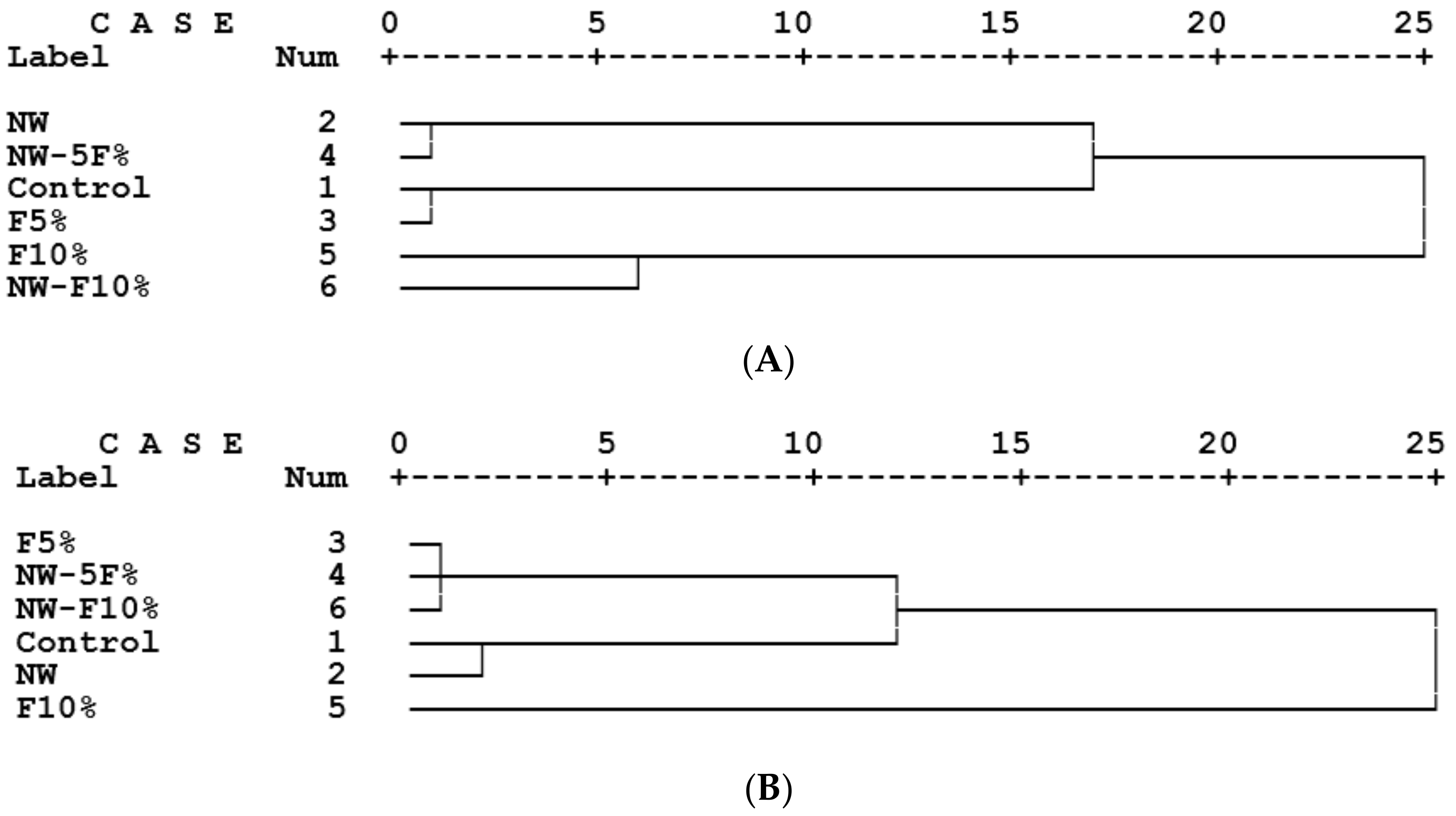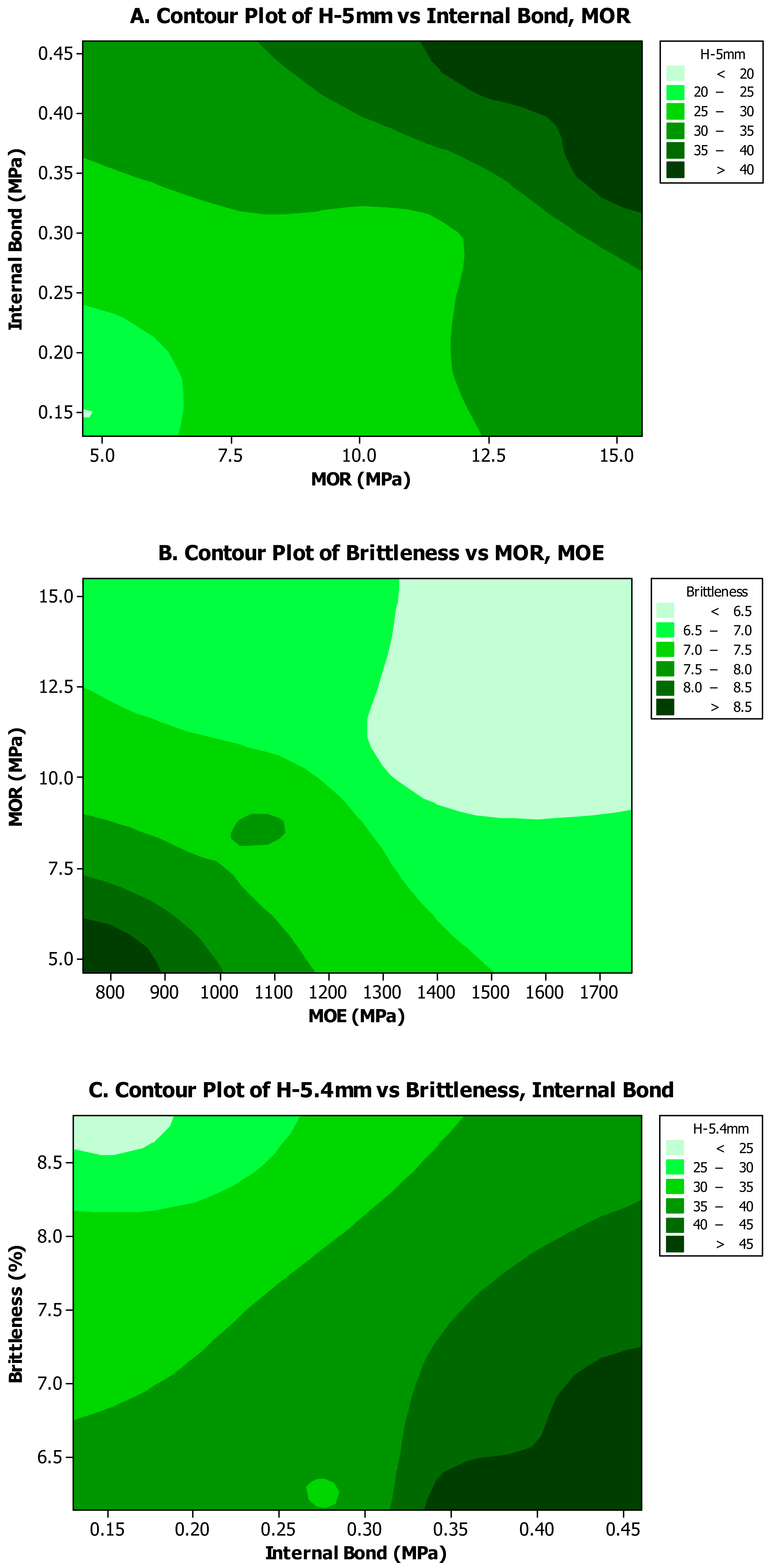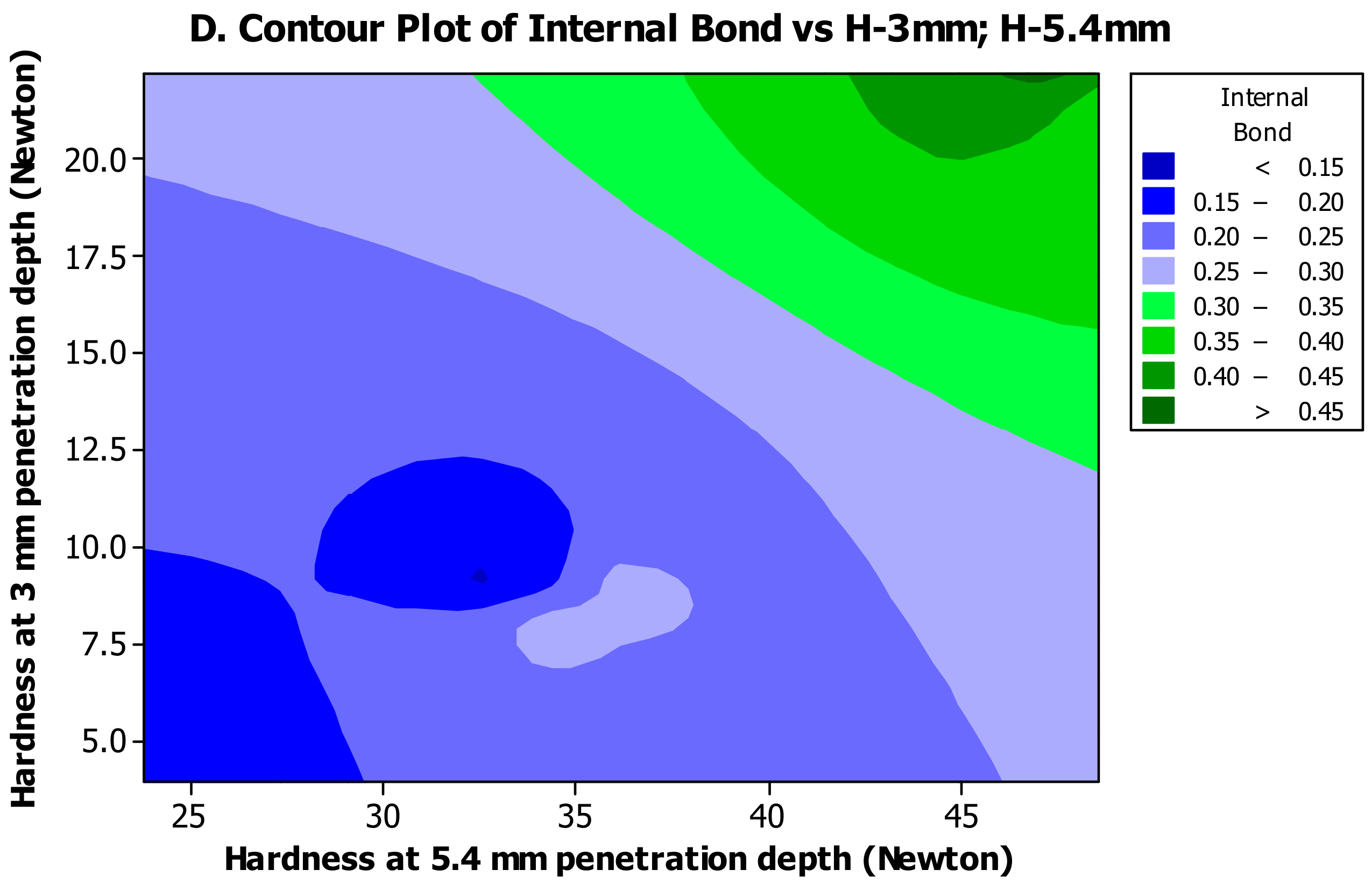Engineering Composites Made from Wood and Chicken Feather Bonded with UF Resin Fortified with Wollastonite: A Novel Approach
Abstract
1. Introduction
2. Materials and Methods
2.1. Specimen Procurement
2.2. Wollastonite Application
2.3. Temperature Measurement
2.4. Physical and Mechanical Properties
2.5. Density Functional Theory
2.6. Modelling of Wollastonite
2.7. Modelling of Hemicellulose
2.8. Modelling of Lignin
2.9. Statistical Analysis
3. Results and Discussion
3.1. Temperature of the Core of Composite Mats
3.2. Physical Properties
3.3. Mechanical Properties
3.4. Adsorption of Wollastonite on Wood Cell Wall Polymers
3.5. Relation between Physical and Mechanical Properties
4. Conclusions
Supplementary Materials
Author Contributions
Funding
Acknowledgments
Conflicts of Interest
References
- Hubbe, M.A.; Smith, R.D.; Zou, X.; Katuscak, S.; Potthast, A.; Ahn, K. Deacidification of Acidic Books and Paper by Means of Non-aqueous Dispersions of Alkaline Particles: A Review Focusing on Completeness of the Reaction. Bioresources 2017, 12, 4410–4477. [Google Scholar] [CrossRef]
- Papadopoulos, A.N. Chemical modification of solid wood and wood raw materials for composites production with linear chain carboxylic acid anhydrides: A brief Review. BioResources 2010, 5, 499–506. [Google Scholar]
- Tajvidi, M.; Gardner, D.J.; Bousfield, D.W. Cellulose Nanomaterials as Binders: Laminate and Particulate Systems. J. Renew. Mater. 2016, 4, 365–376. [Google Scholar] [CrossRef]
- Altuntas, E.; Narlioglu, N.; Alma, M.H. Investigation of the fire, thermal, and mechanical properties of zinc borate and synergic fire retardants on composites produced with PP-MDF wastes. BioResources 2017, 12, 6971–6983. [Google Scholar]
- Hassani, V.; Papadopoulos, A.N.; Schmidt, O.; Maleki, S.; Papadopoulos, A.N. Mechanical and Physical Properties of Oriented Strand Lumber (OSL): The Effect of Fortification Level of Nanowollastonite on UF Resin. Polymers 2019, 11, 1884. [Google Scholar] [CrossRef]
- Taghiyari, H.R.; Bibalan, O.F. Effect of copper nanoparticles on permeability, physical, and mechanical properties of particleboard. Holz als Roh-und Werkst. 2012, 71, 69–77. [Google Scholar] [CrossRef]
- Bari, E.; Taghiyari, H.R.; Schmidt, O.; Ghorbani, A.; Aghababaei, H. Effects of nano-clay on biological resistance of wood-plastic composite against five wood-deteriorating fungi. Maderas. Ciencia y tecnología 2015, 17, 205–212. [Google Scholar] [CrossRef]
- Bayatkashkoli, A.; Taghiyari, H.R.; Kameshki, B.; Ravan, S.; Shamsian, M. Effects of zinc and copper salicylate on biological resistance of particleboard against Anacanthotermes vgans termite. Int. Biodeterior. Biodegrad. 2016, 115, 26–30. [Google Scholar] [CrossRef]
- Papadopoulos, A.N.; Taghiyari, H.R. Innovative wood surface treatments based on nanotechnology. Coatings 2019, 9, 866. [Google Scholar] [CrossRef]
- Papadopoulos, A.N.; Bikiaris, D.N.; Mitropoulos, A.C.; Kyzas, G.Z. Nanomaterials and chemical modification technologies for enhanced wood properties: A review. Nanomaterials 2019, 9, 607. [Google Scholar] [CrossRef]
- Mantanis, G.; Athanassiadou, E.T.; Barbu, M.C.; Wijnendaele, K. Adhesive systems used in the European particleboard, MDF and OSB industries. Wood Mater. Sci. Eng. 2017, 13, 104–116. [Google Scholar] [CrossRef]
- Majidi, R. Electronic properties of graphyne nanotubes filled with small fullerenes: A density functional theory study. J. Comput. Electron. 2016, 15, 1263–1268. [Google Scholar] [CrossRef]
- Harsini, I.; Matalkah, F.; Soroushian, P.; Balachandra, A.M.; Balach, A.M. Robust, Carbon Nanotube/Polymer Nanolayered Composites with Enhanced Ductility and Strength. J. Nanomater. Mol. Nanotechnol. 2017, 6, 6. [Google Scholar] [CrossRef]
- Taghiyari, H.R.; Soltani, A.; Esmailpour, A.; Hassani, V.; Gholipour, H.; Papadopoulos, A.N. Improving Thermal Conductivity Coefficient in Oriented Strand Lumber (OSL) Using Sepiolite. Nanomaterials 2020, 10, 599. [Google Scholar] [CrossRef] [PubMed]
- Esmailpour, A.; Majidi, R.; Papadopoulos, A.N.; Ganjkhani, M.; Armaki, S.M.; Papadopoulos, A.N. Improving Fire Retardancy of Beech Wood by Graphene. Polymers 2020, 12, 303. [Google Scholar] [CrossRef]
- Bayani, S.; Taghiyari, H.R.; Papadopoulos, A.N. Physical and mechanical properties of thermally-modified beech wood impregnated with silver nano-suspension and their relationship with the crystallinity of cellulose. Polymers 2019, 11, 1535. [Google Scholar] [CrossRef]
- Taghiyari, H.; Esmailpour, A.; Papadopoulos, A. Paint Pull-Off Strength and Permeability in Nanosilver-Impregnated and Heat-Treated Beech Wood. Coatings 2019, 9, 723. [Google Scholar]
- Taghiyari, H.R.; Avramidis, S. Specific gas permeability of normal and nanosilver-impregnated solid wood species as influenced by heat-treatment. Maderas Ciencia y tecnologia 2019, 21, 89–96. [Google Scholar]
- Karim, M.; Daryaei, M.G.; Torkaman, J.; Oladi, R.; Ghanbary, M.A.T.; Bari, E.; Yilgör, N. Natural decomposition of hornbeam wood decayed by the white rot fungus Trametes versicolor. Anais da Academia Brasileira de Ciências 2017, 89, 2647–2655. [Google Scholar] [CrossRef]
- Taghiyari, H.R.; Mobini, K.; Samadi, Y.S.; Doosti, Z.; Nouri, P.; Reza, T.H. Effects of Nano-Wollastonite on Thermal Conductivity Coefficient of Medium-Density Fiberboard. J. Nanomater. Mol. Nanotechnol. 2013, 2, 1. [Google Scholar] [CrossRef]
- Taghiyari, H.R.; Karimi, A.; Paridah, M.T. Nano-Wollastonite in Particleboard: Physical and Mechanical Properties. Bioresources 2013, 8, 5721–5732. [Google Scholar] [CrossRef][Green Version]
- Taghiyari, H.R.; Bari, E.; Sistani, A.; Najafian, M.; Ghanbary, M.A.T.; Ohno, K.M. Biological resistance of nanoclay-treated plastic composites with different bamboo contents to three types of fungi. J. Thermoplast. Compos. Mater. 2019. [Google Scholar] [CrossRef]
- Taghiyari, H.R.; Kalantari, A.; Kalantari, A.; Avramidis, S. Effect of wollastonite nanofibers and exposure to Aspergillus niger fungus on air flow rate in paper. Measurement 2019, 136, 307–313. [Google Scholar] [CrossRef]
- Taghiyari, H.R.; Bari, E.; Schmidt, O.; Ghanbary, M.A.T.; Karimi, A.; Paridah, M.T. Effects of nanowollastonite on biological resistance of particleboard made from wood chips and chicken feather against Antrodia vaillantii. Int. Biodeterior. Biodegrad. 2014, 90, 93–98. [Google Scholar] [CrossRef]
- Taghiyari, H.R.; Majidi, R.; Jahangiri, A. Adsorption of nano-wollastonite on cellulose surface: Effects on physical and mechanical properties of medium-density fiberboard (MDF). Cerne 2016, 22, 215–222. [Google Scholar] [CrossRef]
- Taghiyari, H.R.; Samadi, Y.S. Effects of wollastonite nanofibers on fluid flow in medium-density fiberboard. J. For. Res. 2015, 27, 209–217. [Google Scholar] [CrossRef]
- Ghahri, S.; Pizzi, A.; Mohebby, B.; Mirshokraie, A.; Mansouri, H.R. Soy-Based, Tannin-Modified Plywood Adhesives. J. Adhes. 2016, 94, 1–20. [Google Scholar] [CrossRef]
- Jahanshahi, S.; Pizzi, A.; Abdulkhani, A.; Shakeri, A. Analysis and Testing of Bisphenol A—Free Bio-Based Tannin Epoxy-Acrylic Adhesives. Polymers 2016, 8, 143. [Google Scholar] [CrossRef]
- Spina, S.; Zhou, X.; Segovia, C.; Pizzi, A.; Romagnoli, M.; Giovando, S.; Pasch, H.; Rode, K.; Delmotte, L. Phenolic resin adhesives based on chestnut (Castanea sativa) hydrolysable tannins. J. Adhes. Sci. Technol. 2013, 27, 2103–2111. [Google Scholar] [CrossRef]
- Ndiwe, B.; Pizzi, A.; Danwe, R.; Tibi, B.; Konai, N.; Amirou, S. Particleboard bonded with bio-hardeners of tannin adhesives. Holz als Roh-und Werkst. 2019, 77, 1221–1223. [Google Scholar] [CrossRef]
- Pizzi, A. Tannins: Major Sources, Properties and Applications. In Monomers, Polymers and Composites from Renewable Resources; Elsevier BV: Amsterdam, The Netherlands, 2008; pp. 179–199. [Google Scholar]
- Pizzi, A. Tannins: Prospectives and Actual Industrial Applications. Biomolecules 2019, 9, 344. [Google Scholar] [CrossRef] [PubMed]
- Winandy, J.E.; Muehl, J.H.; Glaeser, J.A.; Schmidt, W. Chicken Feather Fiber as an Additive in MDF Composites. J. Nat. Fibers 2007, 4, 35–48. [Google Scholar] [CrossRef]
- Aranberri, I.; Montes, S.; Azcune, I.; Rekondo, A.; Grande, H.-J. Fully Biodegradable Biocomposites with High Chicken Feather Content. Polymer 2017, 9, 593. [Google Scholar] [CrossRef] [PubMed]
- Aranberri, I.; Montes, S.; Wesołowska, E.; Rekondo, A.; Wrześniewska-Tosik, K.; Grande, H.-J. Improved Thermal Insulating Properties of Renewable Polyol Based Polyurethane Foams Reinforced with Chicken Feathers. Polymer 2019, 11, 2002. [Google Scholar] [CrossRef]
- Aranberri, I.; Montes, S.; Azcune, I.; Rekondo, A.; Grande, H.-J. Flexible Biocomposites with Enhanced Interfacial Compatibility Based on Keratin Fibers and Sulfur-Containing Poly(urea-urethane)s. Polymer 2018, 10, 1056. [Google Scholar] [CrossRef]
- Acda, M.N. Waste chicken feather as reinforcement in cement-bonded composites. Philipp. J. Sci. 2010, 139, 161–166. [Google Scholar]
- Koch, J.W. Physical and mechanical properties of chicken feather materials. Master’s Thesis, School of Civil Environmental Engineering, Georgia Institute of Technology, Atlanta, GA, USA, May 2006. [Google Scholar]
- Fraser, R.; Parry, D. The molecular structure of reptilian keratin. Int. J. Boil. Macromol. 1996, 19, 207–211. [Google Scholar] [CrossRef]
- Schmidt, W.F. Innovative feather utilization strategies. In National Poultry Waste Management Symposium Proceedings; Auburn University: Auburn, AL, USA, 1998; pp. 276–282. [Google Scholar]
- ASTM D1037-99. Standard Test Methods for Evaluating Properties of Wood-Base Fiber and Particle Panel Materials; ASTM International: West Conshohocken, PA, USA, 1999; Available online: www.astm.org.
- Taghiyari, H.R.; Enayati, A.; Gholamiyan, H. Effects of nano-silver impregnation on brittleness, physical and mechanical properties of heat-treated hardwoods. Wood Sci. Technol. 2012, 47, 467–480. [Google Scholar] [CrossRef]
- Phuong, L.X.; Shida, S.; Saito, Y. Effects of heat treatment on brittleness of Styrax tonkinensis wood. J. Wood Sci. 2007, 53, 181–186. [Google Scholar] [CrossRef]
- Kaith, B.S.; Mittal, H.; Jindal, R.; Maiti, M.; Kalia, S. Environment Benevolent Biodegradable Polymers: Synthesis, Biodegradability, and Applications. In Cellulose Fibers: Bio- and Nano-Polymer Composites; Springer-Verlag: Berlin/Heidelberg, Germany, 2011; pp. 425–451. [Google Scholar]
- Hosseinpourpia, R.; Adamopoulos, S.; Mai, C. Effects of acid pre-treatments on the swelling and vapor sorption of thermally modified Scots Pin (Pinus sylvestris L.) wood. BioResources 2018, 13, 331–345. [Google Scholar]
- Esmailpour, A.; Taghiyari, H.R.; Hosseinpourpia, R.; Adamopoulos, S.; Zereshki, K. Shear Strength of Heat-Treated Solid Wood Bonded with Polyvinyl-Acetate Reinforced by Nanowollastonite. Wood Research 2020; VUPC a.s.: Bratilsava, Slovakia, 2020; in press. [Google Scholar]
- Dinwoodie, J.M. Timber: Its Nature and Behavior; Van Nostrand Reinhold: New York, NY, USA, 1981. [Google Scholar]
- Fengel, D.; Wegener, G. Wood: Chemistry, Ultrastructure, Reactions; Walter de Gruyter: Berlin, Germany, 1984. [Google Scholar]






| Board Density | 0.67 g/cm3 |
| Board Thickness | 16 mm |
| Press Temperature | 175 °C |
| Press Time | 6 min |
| Pressure of Plates | 160 bars |
| Resin Type and Content | 10% urea formaldehyde (UF) resin |
| Resin Characteristics | 200–400 cP in viscosity, 47 s of gel time, and 1.277 g/cm3 in density. |
| Wollastonite Content | 10% of UF resin (based on the dry weight of the resin) |
| Component | Proportion (% w/w) |
|---|---|
| SiO2 | 47.1 |
| CaO | 39.9 |
| Al2O3 | 3.9 |
| Fe2O3 | 2.8 |
| TiO2 | 0.2 |
| K2O | 0.04 |
| MgO | 1.4 |
| Na2O | 0.2 |
| SO3 | 0.05 |
| Water | The rest |
© 2020 by the authors. Licensee MDPI, Basel, Switzerland. This article is an open access article distributed under the terms and conditions of the Creative Commons Attribution (CC BY) license (http://creativecommons.org/licenses/by/4.0/).
Share and Cite
Taghiyari, H.R.; Majidi, R.; Esmailpour, A.; Samadi, Y.S.; Jahangiri, A.; Papadopoulos, A.N. Engineering Composites Made from Wood and Chicken Feather Bonded with UF Resin Fortified with Wollastonite: A Novel Approach. Polymers 2020, 12, 857. https://doi.org/10.3390/polym12040857
Taghiyari HR, Majidi R, Esmailpour A, Samadi YS, Jahangiri A, Papadopoulos AN. Engineering Composites Made from Wood and Chicken Feather Bonded with UF Resin Fortified with Wollastonite: A Novel Approach. Polymers. 2020; 12(4):857. https://doi.org/10.3390/polym12040857
Chicago/Turabian StyleTaghiyari, Hamid R., Roya Majidi, Ayoub Esmailpour, Younes Sarvari Samadi, Asghar Jahangiri, and Antonios N. Papadopoulos. 2020. "Engineering Composites Made from Wood and Chicken Feather Bonded with UF Resin Fortified with Wollastonite: A Novel Approach" Polymers 12, no. 4: 857. https://doi.org/10.3390/polym12040857
APA StyleTaghiyari, H. R., Majidi, R., Esmailpour, A., Samadi, Y. S., Jahangiri, A., & Papadopoulos, A. N. (2020). Engineering Composites Made from Wood and Chicken Feather Bonded with UF Resin Fortified with Wollastonite: A Novel Approach. Polymers, 12(4), 857. https://doi.org/10.3390/polym12040857







